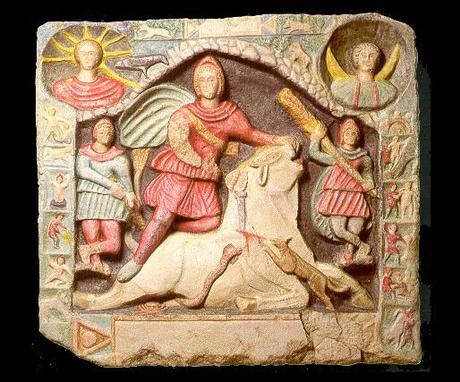In his 1880 Hibbert Lecture on the history of early Christianity, Ernest Renan commented: “I sometimes permit myself to say that, if Christianity had not carried the day, Mithraicism would have become the religion of the world.” While it is doubtful that a Persian-influenced mystery cult that appealed primarily to Roman soldiers, officials, and aristocrats might have become a world religion, there is no doubt that the Mystery Cult of Mithras was a potent religious force in the Roman Empire during the first through fourth centuries A.D.
Because Mithraism came to prominence during those centuries when Christianity was in its formative period, comparisons between the two are inevitable. While some claim that Christianity borrowed heavily from Mithraism or was modeled on it, this seems unlikely and arguments to this effect are more polemic than history. The Roman elites devoted to Mithras were quite different from the provincials devoted to Christ, and these differences are reflected in the two religions.
If there is any correspondence between the two, it is one of changing sensibility. To the extent early Christianity was pacifist and loving, it held little appeal for Roman soldiers and aristocrats who valued strength and virility. With its primary icon being the sun god Mithras (who is usually portrayed as slaying a wild bull) and its primary ritual being a communal feast among “brothers,” the cult was well suited to those whose business was war.

Mithras Slaying the Bull
While Constantine’s 4th century A.D. conversion gave Christianity a substantial boost, Roman elites were skeptical and slow to follow. The subsequent adoption of Christianity as the official religion of empire had many consequences, one of which was that it had to serve the interests of empire. Because one of those interests is war, I suspect that at least some of the martial elements of Mithraism were incorporated into Christianity. The mature (and militarized) fruits of this incorporation appeared several centuries later, during the Crusades. The rituals of the Knights Templar and other Christian military orders bear a striking resemblance to the Mithraic rituals so favored by Roman legionnaires.
Whatever the connections, the origins of Mithraism remain (appropriately enough) a mystery. In the late 1800s, the renowned Franz Cumont inaugurated a debate that continues to this day. In “The Mysteries of Mithras: A New Account of Their Genesis,” Roger Beck convincingly argues for an origin in the eastern border province of Commagene. The Kingdom of Commagene was in the right place at the right time and when it was incorporated into the Roman Empire, Commagenian elites would have carried the cult to Rome.
Although the Mithras cult was not present in Rome during the late republic or early empire (circa 49 BCE), several cults worshiped bulls and sacrificed them during rituals. There is a great scene from the HBO/BBC miniseries “Rome” that depicts one such sacrifice in gory detail:
Bull worship and sacrifice is undoubtedly much older and may go back several thousands of years to late Neolithic hunter-gatherers and probably was present in the earliest Neolithic communities such as Catal Hoyuk. The Mithraic adoption of bull symbolism was in all likelihood an homage of sorts to the distant past.
Reference:
Beck, R. (1998). The Mysteries of Mithras: A New Account of Their Genesis The Journal of Roman Studies, 88 DOI: 10.2307/300807



